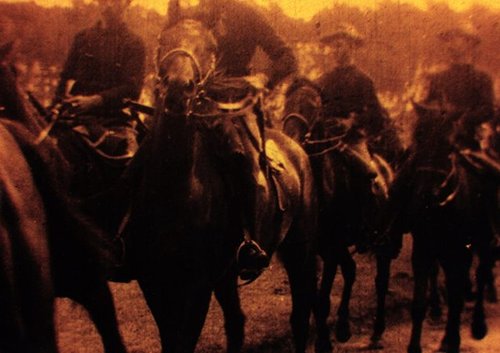
By Miranda Kaye
The Departure of the Second Contingent for the Boer War is the oldest New Zealand film in the Film Archive’s collection [now part of Ngā Taonga Sound & Vision]. It depicts a parade of young New Zealand soldiers on the eve of their departure to fight alongside their British countrymen in the South African Boer War. The fact that such an event was recorded at the time is remarkable enough, but the story of how the fragile footage survived, was identified and lovingly preserved by the Film Archive’s team of conservators and historians is testament to the important role that film plays in defining our culture and heritage.
The early days of film
Through the last decade of the nineteenth century, many developments spurred the growth of moving pictures. In Europe and the United States, inventors and scientists worked, often with surprising similarity, to create a viable moving picture system that would capture an image and allow it to be seen by an audience. By 1900, moving pictures were being filmed and shown all over the world, including in New Zealand.
Of the earliest filmmakers, three are most well-known: Thomas Edison, and the Lumière brothers, Auguste and Louis. Working on different continents, these men were very influential in making pictures move.
In the United States, in 1891, Thomas Edison patented a camera he called the Kinetograph, and the Kinetoscope, a machine that the viewer could look into to watch short moving pictures.
Edison’s inventions, however, did not allow film to be projected onto a screen. In 1894, the Lumière brothers of France made the Cinematographe, a machine that could film and project moving pictures. With it, they filmed outdoor single shot films of real events. On 22 March, 1895, the brothers held a public screening of their first film, Workers Leaving the Factory. Consisting of about 800 frames, the film was only a minute long.
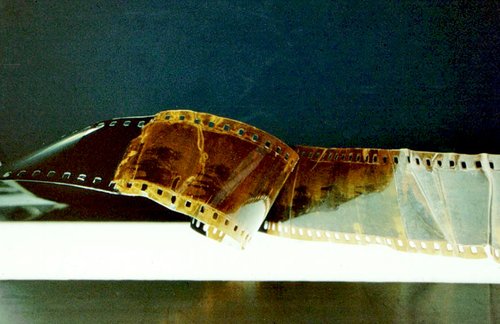
Nitrate film of the Departure of the Second Contingent
Film comes to New Zealand
The first public film screening in New Zealand was in Auckland on 13 October, 1896. Professors Hausmann and Gow introduced ‘Edison’s latest marvel, the Kinematograph’, with which they showed a programme of short films – the first public film projection in New Zealand. The screening was part of a show by Charles Godfrey’s Vaudeville Company, a circumstance that was not unusual for early cinema. Still a new form of entertainment, film was often shown alongside lantern slides and the musical phonograph.
The films screened by Godfrey’s company included a bathing scene on the sands at Folkestone; a street scene in Leeds, and a scene from the The Milk White Flag, among others.
The day after the screening, the New Zealand Herald reported that the reproductions showed the marvellous ingenuity of the inventor. ‘Everything moved as though in life: in fact, it was life reproduced. So natural was it that the moving figures on the screen were cheered.’ Such a strong reaction to moving pictures was not unusual – audiences in Paris had allegedly been panic-stricken by the Lumières’ film of a train that looked like it was coming off the screen and straight toward them.
It was to be a few more years before the first films were shot in New Zealand. In keeping with the close relationship between film and vaudeville, New Zealand’s first filmmaker was Alfred H. Whitehouse, a travelling showman. Like so many showmen overseas, Whitehouse could see the potential in moving pictures for drawing audiences to his shows. In 1899, he wrote to the Colonial Secretary, James Carroll, ‘I have the first and only camera in New Zealand for taking animated pictures for the Kinematograph’. He had, he wrote, filmed ‘three Māori Regatta Scenes at Ngāruawāhia, and a scene of the opening of the Auckland Exhibition’.
The film of the opening of the Auckland Industrial and Mining Exhibition, on 1 December, 1898, was the first shot in New Zealand. With the assistance of William H. Bartlett, a photographer, Whitehouse shot a further nine films between December 1898 and mid-1900. In 1900, Whitehouse visited the Paris Exhibition, returning to New Zealand with a new projector and some new films to screen. After his return, however, he never made another film of his own.

Nitrate film of Departure of the Second Contingent
Of the ten films made by Whitehouse, the only one known to have survived is The Departure of the Second Contingent for the Boer War.
At the end of 1993, a small piece of tightly wound nitrate film, possibly no more than 50 feet long, was deposited with the Film Archive. While being accessioned, it was realised that the contents demanded a closer look. Could it be early New Zealand footage?
The film was so brittle that merely examining it could cause additional damage. Conservators carefully took a series of frame enlargements, which were shown to historians and archivists. Experts agreed that the film was of soldiers departing Wellington for the Boer War in 1900 and was most likely Whitehouse’s film of the Second Contingent. The Film Unit, the laboratory we send our nitrate films to for preservation printing [in 2002], was also consulted. They felt that, even after modifying the printer to allow for excess shrinkage and curl, the Film Unit would not be able to print the film.
This meant that the Film Archive possibly had the earliest surviving piece of New Zealand film on our hands and that it might not be able to be preserved.
The film was as brittle as eggshells. Even with extreme care, new breaks would appear each time it was handled. To ease this handling difficulty, each piece was taped together and wound around a specially constructed core. The film and its core were then suspended over a fuming agent of glycerol and hot water, which was replaced daily. Doing this for an hour each day made the film relaxed enough to work on.
Problems and solutions
Because of the persistent springy brittleness of the film, standard repair techniques were not appropriate. Usually, during repair work, the film is held steady on the work bench by small weights, and repair is done with a minimal amount of clear, perforated repair tape, which must be placed carefully over the sprocket holes that run along the length of the film.
Instead, conservators resorted to using large amounts of tape and, because of the edge curl, it was necessary to secure the edges of the film to the bench with masking tape. It was unorthodox, but conservators did whatever they had to in order to hold the film together.
In many instances, the emulsion (picture holding layer) separated from the base as the film was uncurled. The emulsion was re-attached with nitrate cement and secured with clear tape. The emulsion had also flaked off some frames where breaks had occurred. To prevent further flaking, film repair tape was used over the entire area. This had to be done very carefully, as the pieces of tape had to fit within the line of the frame – and if the tape was placed incorrectly, moving it would lift more emulsion.
Although The Departure of the Second Contingent for the Boer War is only 33 seconds in duration, the repair and preservation work took the Archive’s conservation team 160 hours.
As a result of the many breaks in the film, small chips of film had broken off. These were matched like a jigsaw and cemented in place. Edge damage was also repaired with clear tape. As the tape was laid down, hundreds of new perforation holes needed to be cut, one at a time, because the film was shrunk by 2.2% – meaning the pre-cut tape would not fit.
In the places where the correct order of the film was uncertain, black frames were inserted to indicate missing images. This allowed for future additions or editing after printing of the material.
The film was stored on the specially constructed core during the entire repair period and eventually became more relaxed and printable when the repair was finished.
During the repair work, consultation was undertaken with L’Immagine Ritrovata Laboratory in Bologna, Italy, who have a special nitrate printer that they thought could possibly process a film as delicate as this one. After the film was sent to them, the Ritrovata Laboratory produced a contact dupe negative, then successfully wet gate printed a dupe negative from which they struck two new prints. The original nitrate was returned to the Archive with the new print material. The film had sustained only a small amount of new damage to two frames – a remarkably successful repair project.
Although The Departure of the Second Contingent for the Boer War is only 33 seconds in duration, the repair and preservation work took the Archive’s conservation team 160 hours.
Confirming the origin of a film is an important part of understanding it. Knowing who filmed it, when and why, can turn a small piece of celluloid into a valuable historical document.
When the film that has come to be known as The Departure of the Second Contingent for the Boer War was first deposited, it was unclear exactly what the film actually depicted. At first, it wasn’t even certain that the film was from New Zealand. However, the film was so old that, even if it turned out to be a foreign film, it most likely would be important to its country of origin.
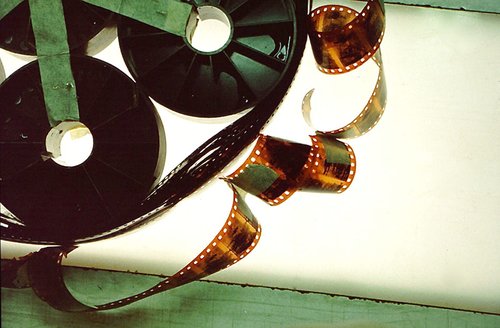
Repairing Departure of the Second Contingent film
Call in the experts
Key to the identification process was New Zealand military historian, Dr Chris Pugsley. Since the late 1980s, Dr Pugsley had done extensive research on the Film Archive’s early films of military and civic events and, as a Stout Research Fellow, was a frequent visitor to the Archive’s reference library. He still remembers the day he heard about the Boer War film.
‘I remember coming into the Archive and the Film Conservator coming down and saying that she had this tiny roll of film in a highly fragile state. The frame markings and the make of the tin suggested it was very early material – and would I have a look at it, and see what I thought?
‘When I looked at it and saw the figures on horseback, I got very excited. My initial reaction that this was a New Zealand scene and this was a Boer War period film. Because I had worked on the Duke and Duchess of York material (from 1901), I knew this made it very early film indeed.’

Modified film core on which Departure of the Second Contingent was stored
Checking the facts
Dr Pugsley suspected the film was of the Boer War Second Contingent, but he suggested that second opinions be sought from other military historians.
Frame enlargements were made from the film and sent to experts on weapons, uniforms and equipment of the period. The frames were chosen to clearly show the men’s uniforms, their horses, and the background, so that identification would be possible.
The frame enlargements were sent to Len King, Tim Ryan and Malcolm Thomas. ‘I didn’t tell them where it had come from’, remembers Pugsley, ‘or that it was from film, but simply asked for identification. Each came back confirming Second Contingent, and tying it down exactly with their own areas of expertise.’
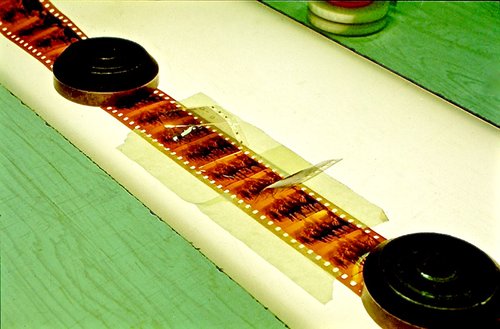
Repairing Departure of the Second Contingent
The response
Without knowing about the discovery of the film, or the origin of the photographs they were shown, the three responses were remarkably similar.
Tim Ryan believed the film was almost certainly of Newtown Park, because the crowd on the bank, the trees in the background and the tents close up to the hill tallied with other photographs of the era. He later wrote, ‘I would guess that the film portrays one of the early contingents to the Boer War, possibly the First, Second or Third. The Mounted Officer wears a uniform which conforms to the Regulations set out in the New Zealand Gazette, dated 24 June, 1891.’
Len King concurred, suggesting it was probable that ‘the reel was shot at a Newtown camp ‘open’ day, given the backdrop and troopers in fatigue navy jerseys. This would likely be the second or third contingent – about January or February 1900. Overall, one could say that the shots are most probably taken before 27 February, 1900.’
Malcolm Thomas’s comments supported the opinions of his colleagues. ‘The troops appear to be of the Boer War period and of early New Zealand Contingents. They appear to be either exercising or en route – but not for a parade as the uniform is a form of fatigue or undress, with the dark blue jersey instead of drill tunic. The early contingent is suggested by the leather 1888 style equipment – it was obtained from volunteer units for at least the First Contingent. Later contingents had bandolier equipment.’
Dr Pugsley added: ‘I have been able to identify similar uniforms in a photo taken of the Second Contingent at Newtown Park. Both the details of dress and weapons establish it as having been taken before the end of February 1900. During this period three contingents were raised for the Boer War. The First Contingent trained at Campbell’s farm in Karori, the Third Contingent was raised and trained in Canterbury, leaving the Second Contingent, which was raised and trained at Newtown Park, as the only possibility’.
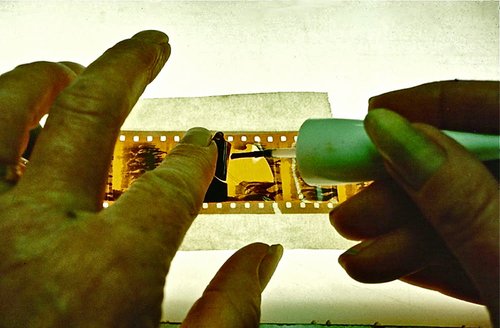
Film clues
Every film carries clues about its origins. Film stock – the filmstrip itself – can be dated through a combination of stock markings, and an expert knowledge of technological changes in film production.
Assistance in this area was provided by Archives New Zealand film archivist, Clive Sowry, who confirmed the Archive’s suspicions that the film had been shot by Whitehouse. It was known that Whitehouse filmed the Second Contingent at Newtown, but no trace of the film had ever been found. Sowry identified the canister the film came in as being a Carbutt Film Container. Carbutt was an early film manufacturer that supplied Thomas Edison with some of his early nitrate film and later supplied the cinematic trade.
The oldest film
The canister, the film stock characteristics, and the film’s content all pointed to a single conclusion. There was no doubt that the film was of the Second New Zealand Contingent for the Boer War, filmed by Alfred Whitehouse in 1900.
It is likely that the film was shot in January 1900, possibly at an open day and parade held over the weekend of 13 and 14 January. A large crowd was in attendance that weekend, and can be seen in the background of the footage, located on an embankment surrounded by trees. The Second Contingent sailed for South Africa on January 20, so this film probably portrays the departing soldiers’ farewell event.
The Departure of the Second Contingent for the Boer War is the oldest surviving New Zealand film, and an irreplaceable historical record.
For more on nitrate, read our recent blog about the annual wind through.
Hero image: screengrab from The Departure of the Second Contingent for the Boer War.